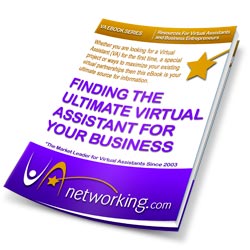Finding the Ultimate Virtual Assistant for Your Business
Building the Foundation — The 4 Step Approach
If you follow this 4 step approach you will be well on your way to building a successful partnership.
STEP 1 ~ Establish Trust, Build Rapport
Your business partnership with your Virtual Assistant will be based on achieving the common goal of “assisting you with your business endeavors”. Initially, your Virtual Assistant will be focused on learning the in’s and out’s of your business and working style while your focus will be on building a rapport and getting to know more about your Virtual Assistant.
|
Building the foundation for a successful partnership will take time and dedication by both parties.
|
Since this is a virtual partnership, the traditional methods of communication such as eye contact and body language are automatically ruled out. Instead, you can combine the use of soft skills, details, respect and wit to start developing a virtual rapport. Active listening, paraphrasing and displaying empathy are great tools to engage people on a significantly higher level. You must also rely on the traditional behavioral attributes of integrity, initiative, business acumen and self control to sustain the connection.
STEP 2 ~ Delegation
The simple steps outlined below, will help you to effectively delegate your workflow, while making the process more streamlined.
- Prepare a summary of your business processes throughout the year. Include short and long term goals, special projects, events, and major deadlines that are vital to your business success. Providing the VA with this insight will set their expectations and allow them to assess the key information about your business to help you meet your milestones.
- Make a list of the tasks you dislike, are less skilled at performing and find time consuming. Estimate how much time these tasks actually take up in a month. Delegating these tasks will be fun and getting your time back will be productive.
- Create custom categories for your tasks. Think in terms of priority, urgency and productivity. This process will allow you to take stock of what needs to be done and when, group the related tasks, and prioritize the workflow.
Other key points to consider when delegating your workflow include understanding skill sets, having confidence in others abilities, setting manageable time frames, allowing room for learning curves and accepting mistakes.
| Fill out the handy chart (included in FREE eBook) to categorize your tasks; it can easily be customized to fit into your overall business plan. |
STEP 3 ~ Feedback
Providing regular feedback is a good way to moderate the workflow while keeping your VA engaged. Use the following steps as a guide:
- Set Review Checkpoints: Whether the intervals are predetermined, random or a combination of both. By establishing a timeframe you will be able to plan ahead to ensure the communication takes place on a regular basis.
- Provide Constructive Feedback: Recognizing and letting your VA know when they have gone above and beyond, made a mistake or left out some pertinent details in a project is a critical factor in shaping a successful partnership.
- Ensure Effective Use of Time: Reviewing the timesheets on a regular basis is a good way to gauge how much time it takes your VA to complete specific tasks. If there is an area that stands out ask them to explain it in detail. Sometimes, you could hold some key information that will fill in a gap, enhance a skill or give them that added information to make the process more efficient.
- Review Quality of Work: The quality of work must meet your standard as well as the standard set out in the contract. If there are any elements in which you are not completely satisfied you must address this concern with your VA immediately.
- Reference Examples (Positive & Negative): When providing feedback, keep a running list of concrete examples to reference. Using specific examples will help the VA visualize the information.
| Urgent/Important: Top priorities, time sensitive, urgent, must do tasks. |
Less Urgent/Important: Tasks that are not as time sensitive yet still are important and necessary. |
Wish List: Tasks you would like to research and/or implement. |
STEP 4 ~ The Partnership
Once the foundation has been set the partnership will start to take shape. Some of the top benefits of being able to collaborate with your VA on such a high level are:
Sharing a Clear Vision: Ability to set goals, meet milestones, review results and improve processes accordingly.
Organize Workflow Effectively: Ability to categorize and balance multiple priorities, determine and carry out challenging deadlines and accept change.
Engage in a High Level of Cooperation: Able to work together harmoniously to achieve common goals. Effectively communicate pertinent information in a timely fashion.
| “Share the Vision and Commit to Achieve it.” |
Make Effective Use of Technology: Automate systems and procedures that compliment existing work habits. Ability to recognize when technology will hinder rather than facilitate workflow. Able to share tips and tricks that will enhance performance.
Enhance Proficiency in Industry Niche: Ability to remain competitive in the market place by keeping up to date on industry news, practices, technology and procedures. Able to identify the right trends to incorporate into the business practice on a regular basis.
Set Measurable Results: With the vision in mind, develop methods that will measure results on a regular basis. This information can then be used to enhance performance and tweak processes as the business evolves.
| “Setting periodic review dates, especially on large scale projects, is an effective way to achieve the desired results.”Find a Virtual Assistant Today – Submit RFP |
Back to Main Index – Finding the Ultimate Virtual Assistant



